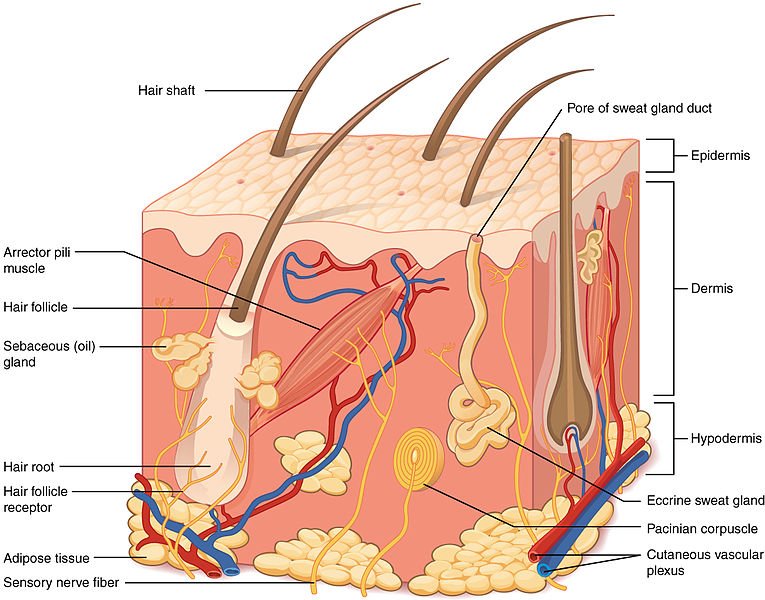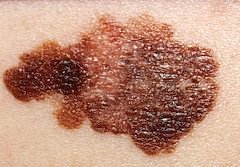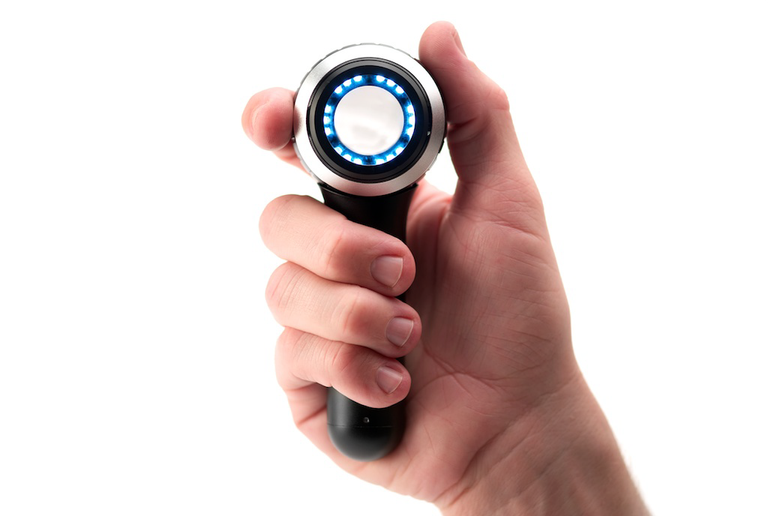Introduction
 Author - OpenStax College [License: Wikimedia commons]:
wikimedia
Author - OpenStax College [License: Wikimedia commons]:
wikimedia The skin is the peripheral covering of the human body and performs lots of function, ranging from protecting the body, which explains its stretchy nature, down to receiving [sensory stimuli](https://en.m.wikipedia.org/wiki/Stimulus_(physiology) from outside the body. This soft outer tissue, covers a total area of about 20 square feet and happens to be the largest organ in the human body. Other functions performed by the skin includes, regulation of body temperature, protection of the body from foreign invaders that could possibly cause infections and other complications.
Just like many other types of cancer, skin cancers often does not begin in an obvious manner. Most skin cancers begin as precancerous lesions. Precancerous lesions in most cases looks mild at first and may not be considered cancerous yet, but has the tendency to escalate if left unattended to. This shift is often referred to as dysplastic changes
The 3 main different kinds of skin cancers, include: basal-cell skin cancer, squamous-cell skin cancer and melanoma. The first two are known as nonmelanoma skin cancer. For the sake of this post, we will be focusing on the most common form of skin cancer, known as melanoma.
Melanomas are cancers arising from the skin, and occurs when skin damages caused by undetected and unrepaired DNA causes mutations in our skin cells, thereby leading to rapid growth and multiplication of dysfunctional skin cells which goes ahead to form cancerous tumors if not detected at a early stage.
Metastatic Melanoma is the most dangerous form of skin cancer. This is because metastatic skin cancer does not just affect the skin alone, it goes ahead to spread beyond the skin to other parts of the body. It is peculiar to the pigment producing part of the skin. during its initial stage, the dysfunctional cancer cells remains in the skin, but begins to spread to the lymph nodes and other parts of the body when allowed to metastasize to late stage. It is important to note that a melanoma may resemble an abnormal mole in its early stage, and can be treated surgically if detected very early.
There are certain melanomas that aren't very easy to detect, because they are located in sensitive areas of the body, including the eyes, genitals or even our feet bottom. Mostly, these are the ones that aren't easily detected and therefore left untreated. This often results in the cancer spreading (metastasis) to other organs of the body like the lungs, kidney, brains, etc. This is when melanoma becomes life threatening, when melanoma gets to stage 3 or 4, it is also known as metastatic Melanoma.
Lets talk about survival rate in metastatic Melanoma

There are certain factors that determine the survival rate of late stage melanoma, including: The state of the patient's immune system, stage of the cancer, melanoma's location, age, etc.
Oncology is improving with each moon. Just within few decades, we have seen oncology evolve from what we know as traditional chemotherapy, which is aimed at destroying general dysfunctional cells, down to advanced therapeutic approaches which involves targeting these bad cells, and dealing with them specifically with very minute side effect.
Prior to the introduction of certain advanced therapeutic approaches towards melanoma, Metastatic melanoma had a 5year survival rate of 15-20%, and a 10 year survival rate of 10-15%. Certain advanced treatment options like targeted therapies and others, are now increasing the survival rates rapidly.
Traditionally, metastatic Melanoma treatment included radiation, surgery, chemotherapy. But there are more effective and clear cut ways of treating melanoma in this new age. An example of this, is the use of immunotherapy, which involves boosting the ability of the immune system in order to destroy these dysfunctional cells.
Targeted cancer therapy is another effective 21st century therapeutic approach towards melanoma. Even though it has not yet been proven to work for everyone, like the case of individuals who have tumors of a mutated form of protein called BRAF. BRAF causes unchecked cancer growth, and targeted therapy has been proven to correct this. Furthermore, targeted therapy promises an even better way to combat melanoma cancers with very little side effect compared to other treatment types.
So what actually causes this dreaded disease called Melanoma
There is no certain cause of melanoma. however, exposure to ultraviolet light (UV) is recorded to be at the top of the list, when considering the risk factors. Other risk factors include: family history, moles in its active stage, type of skin, genetic risk factors, etc.
Researchers say there are cases (About 70-80%) where a melanoma does not come from an existing mole, rather they appear in our normal skin, and all of a sudden, develop a thickening, a spot, or other skin irregularities. This is very dangerous, and can spread to the lymph nodes and other parts of the body if not tackled early enough.
Let me show you an advanced level beyond melanoma treatment
 Image of a dermoscope [CC0 Creative Commons]:
pixabay
Image of a dermoscope [CC0 Creative Commons]:
pixabay Recommending the type of treatment to use in a case of melanoma is largely dependent on the stage of the tumor. For example, a recommended treatment for stage one melanoma which can be surgically cut out within 5 minutes, is totally different from a situation where the tumor has gone beyond stage 1 and 2, and has began to metastasize throughout the body. In this case, treatment options like Chemotherapy, radiation and the likes, will be required. Late stage detection affects melanoma survival rate adversely.
From an elevated point of view, there are two sides to this coin. Humans are awesome at devising new methods of disease therapeutic approach. Most of all the researches and discussions related to melanoma has been targeted towards better ways of combating this deadly disease at its late stage, which involves innovating cutting edge technologies, investing in advanced researches, getting the latest drug therapies. All these are done, just to make sure more individuals survive melanoma.
On the other side of the coin, what if we very much increase the survival rate of melanoma by devising better ways of early stage detection which will cost us even lesser amount of money and stress. We could set a goal to get to a point where every individual can reach a doctor during stage one of their melanoma, or better still make early stage detection as simple as changing Tv channels with our remote control. One very effective way to achieving this worthwhile goal, is harnessing the power of our smartphones
How does our smartphone help us fight cancer
Neil Dalley said..
“Being originally from Australia, I had grown up with strong and clear skin cancer educational messages and I realised there was huge potential to help improve the identification of melanoma by leveraging artificial intelligence and smartphones,” he explains..
The founder of skin analytics (Neil dalley) has gone ahead to masterminded the creation of a current and effective tool which is easily accessible to everyone, and can be easily operated with the aid of a smartphone and a special lens known as a dermoscope. This device aids not just detection, but helps in managing the number of people going to healthcare centers to check their moles and lesions. With this tool, we can detect if a mole is cancerous or not, just within minutes, thereby reducing patient delay.
Here is how it works..
Attached to a smartphone, is a special lens called a dermoscope. This device has the capacity to capture high quality images of the lesion with the aid of a data collection app.
The image captured is then analysed to determine if the individual needs the attention of a dermatologist link or not. changes over time can also be tracked using this device. Since this invention, 9 cases of melanoma detection is estimated to have occurred.
This is almost what the dermatologist would have done if the patient where to visit a health care center amongst other advantage of this device, is the elimination of anxiety, which could cause even more health complications in the patient.
Beyond this, we need to come up with campaigns with the aim of educating people on the dangers of ultraviolet light exposure, blistering sunburn, having several ATypical moles, family history of melanoma and other risk factors of melanoma, like the possible risk signals individuals can look out for, in their lesions and moles. We must bring these advanced technologies to the door step of people's homes, only this way, can we make sure everybody play a role similar to that of cancer researchers, which will ultimately lead to an incredible number of individuals, detecting their moles in a very early stage.
Making treatment easier by cutting down patient delay
Patient delay is defined as the interval between the time a disease symptom surfaces in an individual and the time the individual first contacts a health care system. Researches have observed the time interval to be between 6-18months for melanoma cases, which is more than half of the total time to treat this disease. so how does this relate to the reduction of melanoma in our today's society?
Since you ask, i'l like to repeat my question what if we devise a means whereby we can cut down patient delay to the lowest possible level? This is where I think we should focus more attention on, since early stage detection is the best possible preventive measure. What if we cut down this delay by providing more effective methods, education, and tools to make sure early melanoma detection is much more possible within a short timeframe (possibly few hours). This is where I think we should pay more attention to Neil Dalley and his 21st century idea of leveraging artificial intelligence and smartphone, in melanoma detection.
What are the signs to look out for in our moles (ABCDE method explained)
There are certain times our moles and lesions get tricky. The first signs to often check out for, are changes in the already existing mole. and one very simplified way of checking this is the A,B,C,D,E method.
"A" stands for asymmetry. In this case, one shape of the mole does not match the other half. "B" stands for border, this involves looking out for irregular borders. In most cases, the borders are either ragged, notched, or blurred in its edges. "C" stands for color, which could be different shades of brown, flesh, or black. "D" stands for diameter, which could possibly get increased over some months. "E" stands for evolving, which means the mole have changed in the course of few weeks or months
Like I mentioned earlier, melanoma could get really tricky sometimes. Melanomas are known for their varying looks. There are melanomas that show all the ABCDE features, there are also cases where the melanoma displays only one or two of these features. this is another reason why we advise proper checking of any abnormal changes in our moles or lesions, because it might be in its localised stage.
Conclusion
There are a lot of other melanoma treatment approaches which are still in clinical trials
Melanoma remains one of the most dreaded cancer types, and has cost individuals lots of pains, which has raised heavy concerns in our world, leading to certain advanced therapeutic approaches like Targeted therapy and immunotherapy. If you or anyone around you have been diagnosed with melanoma, there are so many reasons to be hopeful.
Melanoma becomes life threatening if left untreated, which is why we must check our skins regularly, and report any abnormal changes observed in our moles to our doctor, for proper examination, or report a family history of melanoma. The use of sun protection is also advised. lets make the world a better place guys.
To be continued...
Thank you,
written by: @akiripromise
Reference
[2] Melanoma
[3] Melanoma skin cancer, webmd.com

Did you know there is a group of forward thinking individuals with the goal of increasing both the quality as well as visibility of Science, Technology, Engineering and Mathematics (STEM) posts on Steemit? well, now you know. The name of our community is @steemSTEM. If you blog, or are interested in professionally blogging on any of the areas mentioned above, do well well to join our discord channel. For more details about the @steemStem community, click hereFurthermore, you can also include the tag #stemng on your post, if you are from Nigeria. Click here for more information about @stemng.
Great content! Thanks!
Thanks @zeurich. I am glad I could be of help
Congratulations! Your post has been selected as a daily Steemit truffle! It is listed on rank 12 of all contributions awarded today. You can find the TOP DAILY TRUFFLE PICKS HERE.
I upvoted your contribution because to my mind your post is at least 17 SBD worth and should receive 119 votes. It's now up to the lovely Steemit community to make this come true.
I am
TrufflePig, an Artificial Intelligence Bot that helps minnows and content curators using Machine Learning. If you are curious how I select content, you can find an explanation here!Have a nice day and sincerely yours,

TrufflePigHi @akiripromise!
Your post was upvoted by utopian.io in cooperation with steemstem - supporting knowledge, innovation and technological advancement on the Steem Blockchain.
Contribute to Open Source with utopian.io
Learn how to contribute on our website and join the new open source economy.
Want to chat? Join the Utopian Community on Discord https://discord.gg/h52nFrV